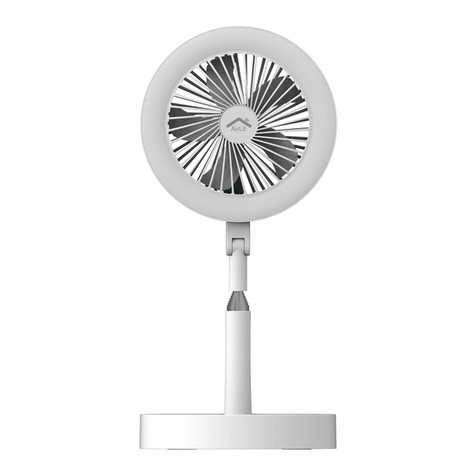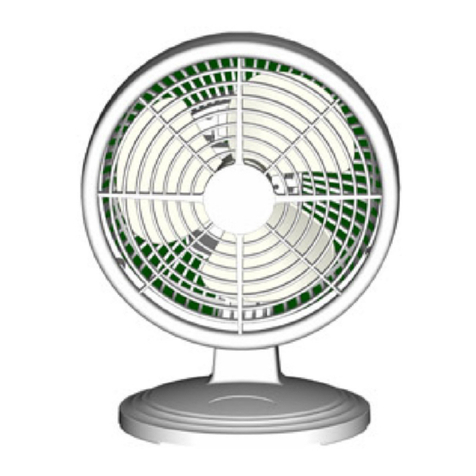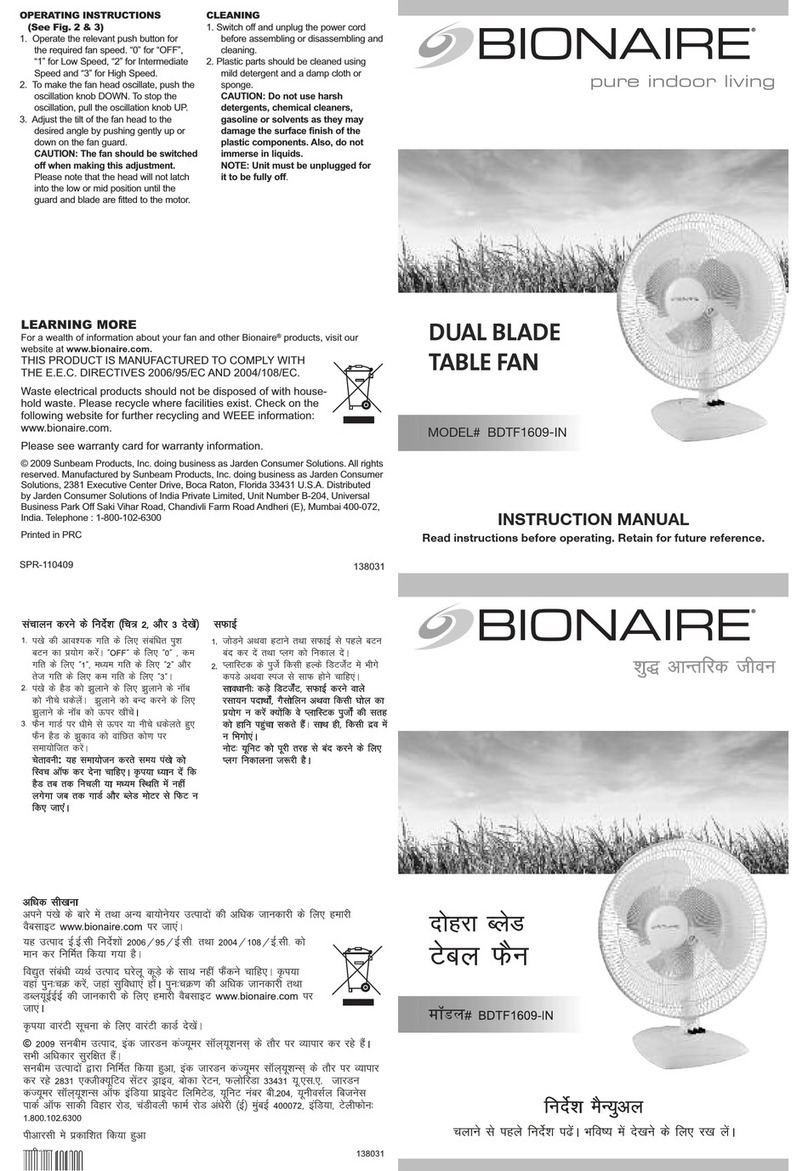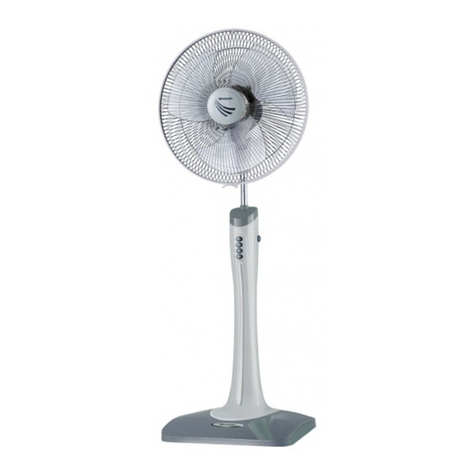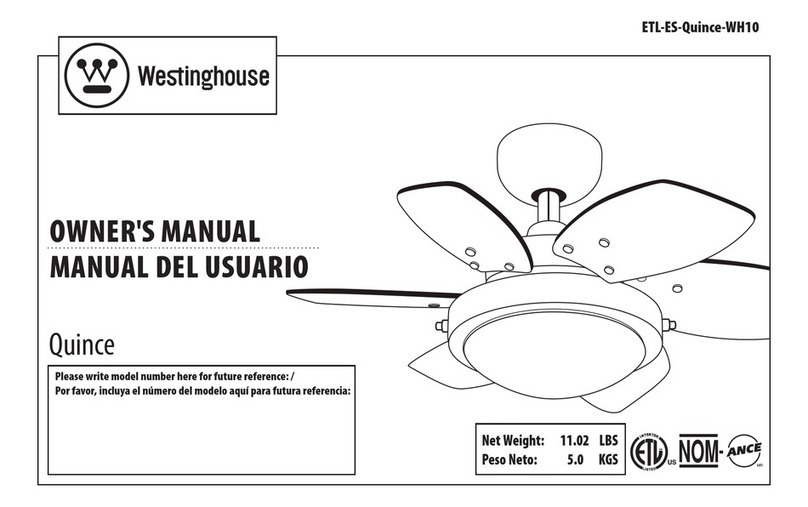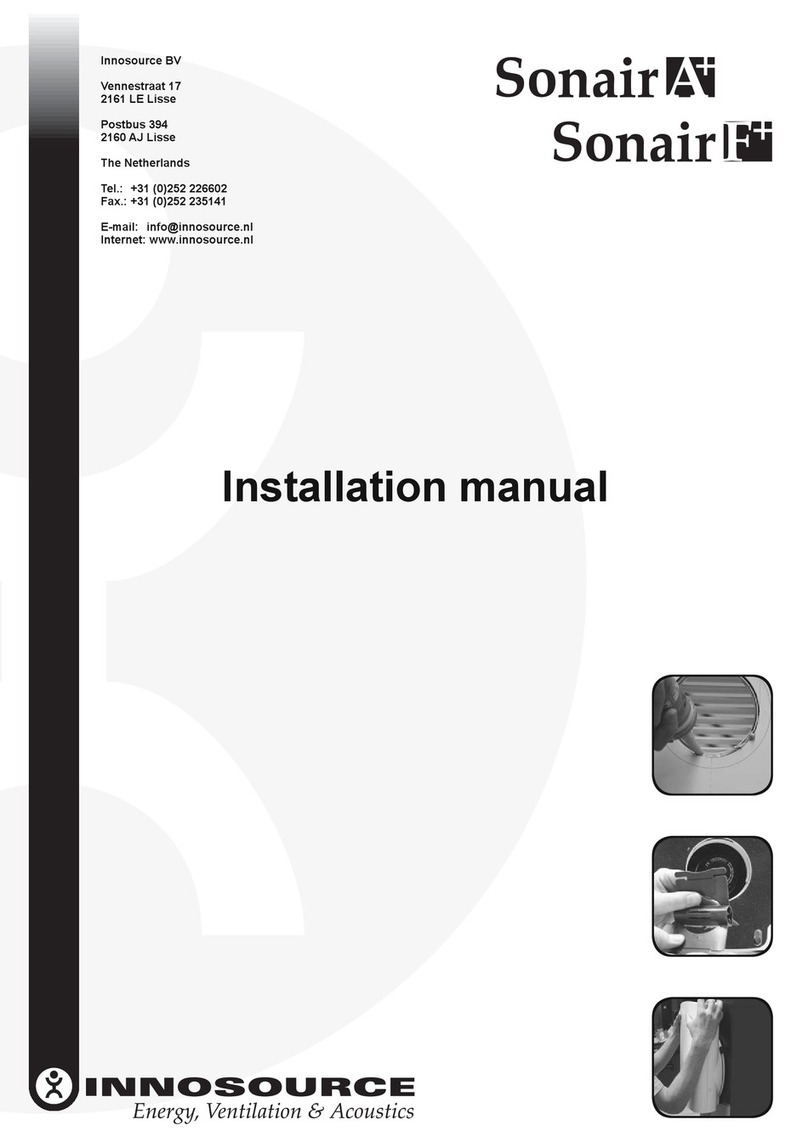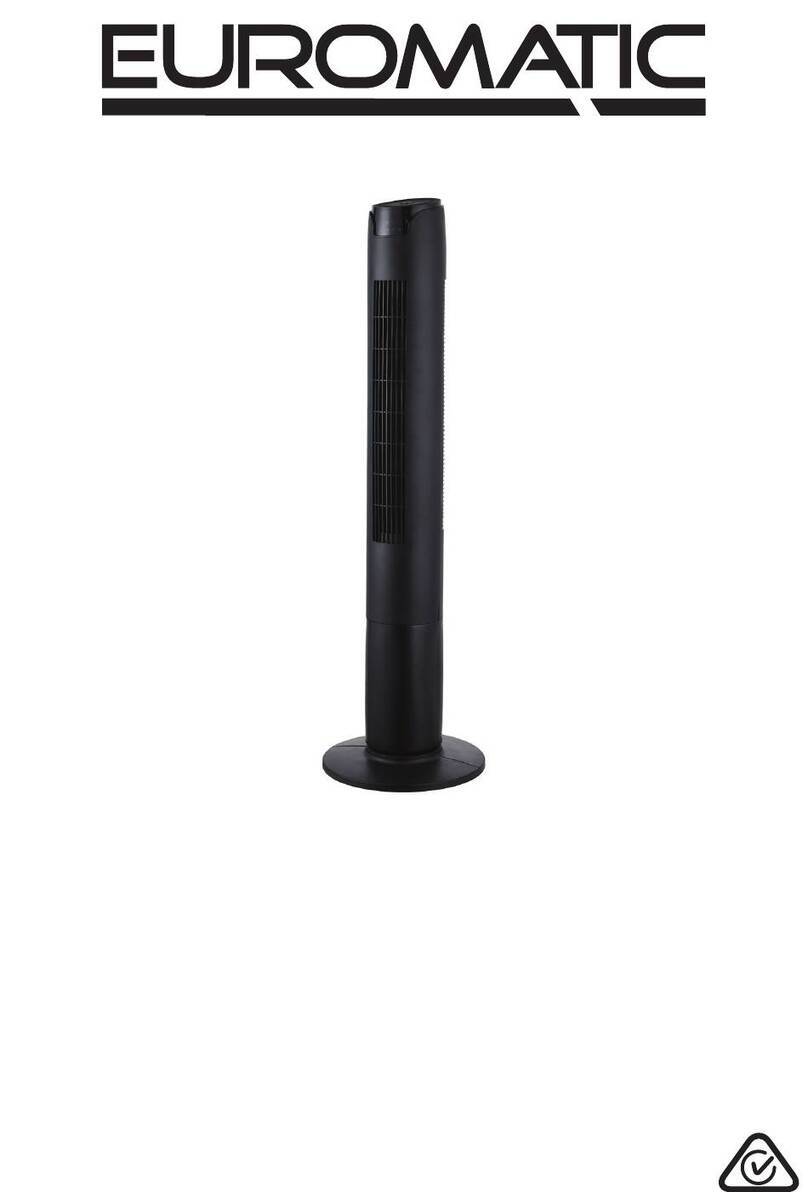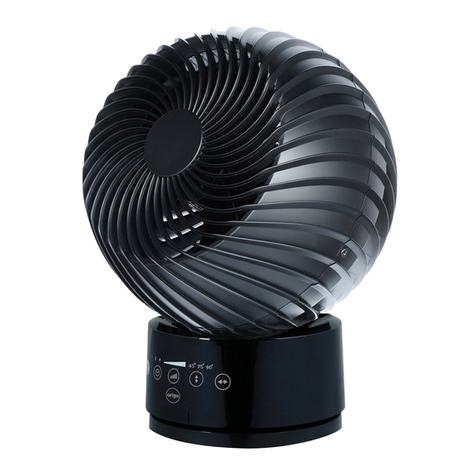Tecme NEUMOVENT User manual

Graph ventilator
Technical manual
(review 04)
MAY 2006

CONTENT
CHAPTER I
GENERAL AND OPERATION FEATURES
TECHNICAL DATA AND SPECIFICATIONS
CONTROL PANEL
SAFETY MECHANISMS
CHAPTER II
MAINTENANCE INSTRUCTIONS
CHAPTER III
TROUBLE SHOOTING
CHAPTER IV
SENSOR VERIFICATION
CHAPTER V
EQUIPMENT OPENING AND CLOSURE
CHAPTER VI
DETAIL OF ASSEMBLIES
CHAPTER VII
ELECTRONIC BOARDS: DETAIL
CHAPTER VIII
CALIBRATION
CHAPTER IX
FINAL CONTROL

CHAPTER I
GENERAL AND OPERATION
FEATURES

TECHNICAL AND MAINTENANCE MANUAL
Graph VENTILATOR
Review : 04
Date:
09/05/06
1
Characteristics and Principles of Operation
Generic definition
It is a device for continuous use foreseen to control mechanically or to help the
patient’s ventilation, giving a predetermined oxygen concentration in the breathing gas
with an adjustable volume or pressure.
Intended use
Purpose and function of the NEUMOVENT Graph Ventilator:
§Lung ventilator for mechanical ventilation of medical application, electric and
pneumatically driven and microprocessor-controlled.
§The intended use is to provide continuous ventilation to patients requiring
ventilatory support. This product is intended to be used in a wide range of
patient from infants until adults and to cover a variety of clinical conditions, and
to be used in short or long terms.
§The device is intended for used in hospitals and hospital-type facilities that
provide respiratory care for patients requiring respiratory support.
Classification
Class: llb (Rule 9). Active therapeutic devices intended to administer or exchange
energy to or from the human body in a potentially hazardous way.
Type: Active medical Device.
Operative Mode: Continuous.
Life Cycle: 5 years if maintenance schedule is followed.
WARNING: Do not use the ventilator in the presence of flammable anesthetics.
An explosion or fire may result.
Description
The NEUMOVENT Graph Ventilator comprises a system of related elements and
designated to alter, transmit and apply energy directly, and in a predetermined mode,
replacing or contributing with the patient's muscular capacity in the execution of the
work of breathing with the intention of achieving an efficient gas exchange.
This function of increase the mechanical support to the patient can be explained for
the following:
1. Control Mechanism. It explains how the machine can work to increase or
supplement the patient's breathing effort.
2. Control Circuit. It defines what types of devices are used to complete this task.
3. Control Variables. It defines which are the dynamic elements that control any
stage in the course of the breathing cycle.
4. Breathing Phases Variables. It explains how the ventilator responds to changes
that produce the beginning, the support and the end of the breathing cycle.
1. Control Mechanism
To understand how the machine can control the substitution or the supplementation
of the natural function of breathing, before, it is required to explain something on the
mechanics of breathing. Specifically on the pressure that is necessary to exercise to
make a flow enters to the airway and increase the volume of the lungs.

TECHNICAL AND MAINTENANCE MANUAL
Graph VENTILATOR
Review : 04
Date:
09/05/06
2
In the course of an inspiration and expiration, there is a change of pressure, volume
and flow. A mathematical model called Equation of the Motion of the breathing
system describes this change.
Equation of Motion
Muscle Pressure + Ventilator Pressure = Volume
+ Resistance x Flow
Compliance
Muscle pressure: Forces generated by the breathing muscles during the inspiration.
Ventilator Pressure: Transrespiratory Pressure generated by the ventilator during the
inspiration (e.g.: pressure of the airway less pressure of the surface of the body).
The combined muscle and ventilator pressure cause volume and flow to be delivered to the
patient. Pressure, volume and flow change with time and hence are variables. The
compliance and the resistance are the constants maintained by the respiratory system.
If the patient’s ventilatory muscles are not functioning, the ventilator must generate all the
pressure required to deliver the tidal volume and the inspiratory flow rate. In this case, it will
control the ventilation.
The NEUMOVENT Graph Ventilator is able to control the pressure waveforms like the flow
waveforms. This control also can be doing in a single inspiration.
2. Control Circuit
The NEUMOVENT Graph Ventilator uses an electronic circuit to perform, control and monitor
the ventilation. The critical components of this system include a microprocessor, pressure
sensors and servo proportional valves.
3. Control Variables
As it was mentioned, the control variables of the NEUMOVENT Graph Ventilator are the
Pressure and the Flow.
The equation of motion establishes that if the Pressure is selected as the control variable,
then the ventilator is a pressure controller. Therefore, the left side of the equation will be
Criteria for determining the control variable
The ventilator is a
Time
Controller
NEUMOVENT Graph
The ventilator is a
Volume
Controller
The ventilator is a
Fow
Controller
Observation
and
previous
knowledge
The ventilator is a
Pressure
Controller
Does pressure waveform
change when patient
resistance and compliance
change?
Does volume waveform
change when patient
resistance and compliance
change?
Is volume measured directly
(by volumetric displacement
rather than by flow
transducer)?
no yes yes
yes no
no
(modify from. Chatburn )
(9)

TECHNICAL AND MAINTENANCE MANUAL
Graph VENTILATOR
Review : 04
Date:
09/05/06
3
determined by the selections made in the ventilator and they won't be affected by the
changes of the right side (compliance and resistance). As it will be seen, the Pressure
Controlled (PCV) and Pressure Support (PSV) modes use the pressure as the control
variable.
If the change of volume (VT) is maintained stable when the compliance or the resistance
change and simultaneously the flow are measured directly (pneumotachograph), then the
ventilator is classified as a flow controller.
The Volume mode of the NEUMOVENT Graph Ventilator uses the flow as the control
variable. The Pressure Support mode with Volume Assured is able to change, in oneself
inspiratory phase, from pressure controller to flow controller.
4. Breathing phases variables
In each one of the ventilation phases (inspiration and expiration), a particular variable is
measured and used to begin, sustain and conclude the phase. In this context, pressure,
volume, flow and time are referred as the phase variables.

TECHNICAL AND MAINTENANCE MANUAL
Graph VENTILATOR
Review : 04
Date:
09/05/06
4
Principles of Operation
Operative definition
The NEUMOVENT Graph Ventilator is a pressure or flow controller. The inspiration is
triggered by pressure, flow, time or manually. It is pressure, volume or flow limited and
pressure, volume, flow or time cycled.
Two proportional valves, one for air and another for oxygen regulate the flow of gas to the
patient. The valves work simultaneously during each respiratory phase mixing the gases to
get the set FIO2.
The microprocessor receives the airway pressure and the inspiratory flow signals, and it
controls the orders for the adjusted variables and the output signals. The airway pressure
sensor is connected at the beginning of the patient's circuit. This sensor also manages the
feedback signals that are used for pressure triggering, alarms levels, and to control the
pressure waves in the pressure controlled, pressure support and mandatory minute
ventilation modes. Two differential pressure transducers related with the internal and external
pneumotachographs obtain the information of the delivered and exhaled flow. The two output
pneumotachographs are screen type; the expiratory is of variable orifice. Also, the signals of
the first are used to control the flow waveform and the tidal volume regulated as reference.

TECHNICAL AND MAINTENANCE MANUAL
Graph VENTILATOR
Review : 04
Date:
09/05/06
5
Control valves
The mentioned proportional valves regulate the gas flow to the patient. The flow control is
able to send flows up to 180 L/min when the gases are from a central-supply system, and of
120 L/min when a portable compressor provides the air.
Two solenoids valves govern the expiratory valve, one for the closing and opening
(beginning and end of the inspiratory phase). The other one is a low flow proportional valve
that regulates the partial closing of the expiratory valve to produce positive pressure at the
end of the expiration (PEEP). The activity of these valves is coordinated by the
microprocessor, synchronizing its actions.
The system of valves has, also, four solenoids valves that act synchronously every 15
minutes to make a system zeroing (atmospheric pressure) of all sensors. At the same time,
another solenoid valve allows to pass a calibrated compressed air flow to purge the lines of
the expiratory pneumotachograph to avoid the entrance of water and humidity to the sensors.
Control panel
The control panel comprises the keys to select the different modes and functions. In the
center there is a LCD screen where the results appear, so much in numeric data as graphic
representations and messages.
Some keys have lamps to indicate activation of the required function. The graphics in real
time of pressure, flow, volume, pressure/volume and flow/volume loops appear in successive

TECHNICAL AND MAINTENANCE MANUAL
Graph VENTILATOR
Review : 04
Date:
09/05/06
6
form pressing a key. The airway pressure is represented dynamically by an analogical bar
graph.
The numeric values exhibited below and to the right of the screen are those programmed by
the operator. Those of the superior and left part are resulting values.
Some values have small characters, as the indication of high and low alarm limit of VT.
Others are remarkable as the high and low-pressure limit.
The mode in use is shown with highlighted video inverse characters. Above the mode in use
appears, when it is programmed, the sigh and/or pauses indication.
Likewise, the screen shows messages indicating an alarm state or to execute some action.
Respiratory cycle
The process of insulation of gas to the lungs by means of the mechanic ventilation with the
NEUMOVENT Graph Ventilator comprises four steps:
1) Start of inspiratory phase
2) Progression of inspiration
3) End of inspiration
4) Expiratory phase
Start of inspiratory phase
The beginning of the inspiration can be automatic (for action of the respiratory frequency
control) or for the patient's initial inspiratory effort. In the first case the ventilation will be of
controlled type and in second assisted type.
Pressure breathing curves where is pointed out the beginning and the end of
the inspiratory phase.
For selection of assist/control ventilation the Volume (VCV) or Pressure (PCV) modes are
used. The spontaneous ventilation includes, in this ventilator, the Pressure Support (PSV)
mode and its combinations, where the patient begins and ends the inspiration according to
he/she demand.
The inspiratory effort that triggers the inspiratory phase modifies the pressure of the
breathing circuit or it produces variation of a continuous flow in the same circuit. In both
cases the system is regulated by means of the Inspiratory Sensitivity control.
From the mechanical point of view, the closing of the expiratory valve and the opening of the
flow of gas mixture toward the breathing circuit and the patient characterize this stage.
Progression of inspiration
The duration of this stage depends on the time during which comes out flow of the ventilator
toward the breathing circuit and the patient, while the expiratory valve remains closed.

TECHNICAL AND MAINTENANCE MANUAL
Graph VENTILATOR
Review : 04
Date:
09/05/06
7
The form in the flow administration depends on the ventilatory mode and of the selected flow
waveform.
In the VCV mode the flow waveforms, which can be selected, are: descending ramp (decelerating),
rectangular (continuous flow), sinusoidal, ascending ramp (accelerating). In the pressure modes
(PCV and PSV) the flow waveform is decelerating, except in PSV with volume assured where it
could be combined decelerating with continuous flow in the same inspiratory phase.
Layouts of pressure (up) and flow (below) curves. From left to right: Flow in
descending ramp, rectangular, sinusoidal, ascending ramp. Notice the
modifications of the curves of pressure according to the used flow.
End of inspiration
The suspension of the ventilator inspiratory flow depends on the time selected in the VCV
and PCV modes.
In the PSV mode depends on the fall of the inspired flow until a derivative percentage of the
initial flow of that same inspiration is reached. The regulation of this Expiratory Sensitivity can
be made from 5% up to 40% of the initial flow. The default percentage is 25%.
Flow curve during Pressure Support (PSV). In this case the inspiration finishes
when the flow has diminished to 25% of the initial flow (default value).
Expiratory phase
It begins when the expiratory valve opens up allowing escaping the flow exhaled by the
patient. This action is passive and it carries out by the elastic recoil of the lung and the
thoracic cage. Generally, the expiratory flow waveform shows an inverted peak which returns
with variable retard to the zero flow line. The delay in reaching the zero can be due to
expiratory retard of an obstructive lung disease or for breathing circuit defects.

TECHNICAL AND MAINTENANCE MANUAL
Graph VENTILATOR
Review : 04
Date:
09/05/06
8
The expiratory phase can be modifying adding Positive Pressure at the End of Expiration
(PEEP). The NEUMOVENT Graph Ventilator produces this positive pressure by means of a
digital regulation of the closing force of the expiratory valve diaphragm.
Pressure curves during ventilation with
5 cm H2O of PEEP.

TECHNICAL AND MAINTENANCE MANUAL
Graph VENTILATOR
Review : 04
Date:
09/05/06
9

TECHNICAL AND MAINTENANCE MANUAL
Graph VENTILATOR
Review : 04
Date:
09/05/06
10

TECHNICAL AND MAINTENANCE MANUAL
Graph VENTILATOR
Review : 04
Date:
09/05/06
11
Operative modes
According to the described functional characteristics, as well as the controls and limits
assigned to this device, the following operative modes have been included. These modes
agree with the descriptions of the classic world literature, which is mentioned partly in
"Bibliography."
The division in three parts has for object to separate the groups
according to the predominant variable, volume, pressure, or
combined modes. The combined modes include modes with
participation of the two modalities and other where objectives of
tidal volume or minute volume that should be get.
Following is defined and describe the form of action for each
operative mode.

TECHNICAL AND MAINTENANCE MANUAL
Graph VENTILATOR
Review : 04
Date:
09/05/06
12
Volume
VCV Assist/Control
Definition and Operative Proceeding: It is a ventilatory mode with specific
regulation of the tidal volume. The inspiratory pressure is variable, and it depends on
the respiratory impedance to regulated volume.
During this mode, the ventilator works as a flow-controller where the selected flow
waveform is sustained during any lung compliance/resistance variation.
In this mode, the ventilator is time cycled, and the inspiratory flow is automatically
calculated and regulated. This means that for a given volume, the variations of the
inspiratory flow are obtained by means of the regulation of the inspiratory time. It also
explains why a rapid pressure drop without an inspiratory plateau marks the end of
inspiration, unless it is specifically regulated.
In the volume mode, the inspiratory flow can be changed by means of the flow
waveform control key.
The different flows are: descending ramp, constant, sine and ascending ramp. Each
of these flow waveforms also produces characteristic pressure and volume
waveforms.
This mode works with the Assist/Control characteristic, changing from a manner to
other according to the patient's demand (inspiratory effort).
If the patient’s inspiratory effort is reduced or an apnea episode is present, then, the
inspiration will be triggered by time (set machine frequency).
On the other hand, the patient's inspiratory effort could be enough to trigger the
ventilator and begin the inspiratory phase with he/she own breathing frequency and
according with the set trigger sensitivity.
Specific Controls for the VCV mode:
VT: Regulation of gas volume propelled by the ventilator in each inspiration.
Flow Waveform: To change the flow waveform.
Sigh: With selection of sigh Vt; number (1,2 or 3 successively); events per hours (5,
10, 15, 20); insp. pressure limit.
Insp. Pause: With time selection from 0.25 to 2.0 seconds.
Pressure
It comprises modes with specific regulation of the inspiratory pressure. It has two sub modes:
1) Pressure Controlled (PCV) Assist/Control
2) Pressure Support (PSV) and/or CPAP.
In both sub modes the ascending slope of the pressure can be varied with the Rise Time
control.
PCV Assisted/controlled
Definition and Operative Proceeding: In the Pressure-Controlled Ventilation mode
(PCV), the ventilator works as a positive pressure controller because the pressure
waveform remains the same when the patient’s compliance or resistance changes.
The switching from inspiration to expiration is normally regulated by time (inspiratory
cycling by time) or by pressure if the maximum safety pressure limit is reached. As in
all pressure-controlled modes, the ventilatory volume is variable and depends on the

TECHNICAL AND MAINTENANCE MANUAL
Graph VENTILATOR
Review : 04
Date:
09/05/06
13
lung size, the existent pressure gradient at the beginning of inspiration between the
upper airway and the alveoli, the respiratory system compliance and the available
inspiratory time.
The pressure waveform developed during inspiration is rectangular, being the flow of
the descending ramp type (decelerating flow). The typical pressure plotting shows a
rapid lineal increase until the set pressure limit is reached. Pressure is maintained
constant during the set inspiratory time. It cannot be changed.
This mode works with the Assist/Control characteristic, changing from a manner to
other according to the patient's demand (inspiratory effort).
If the patient’s inspiratory effort is reduced or an apnea episode is present, then, the
inspiration will be triggered by time (set machine frequency).
On the other hand, the patient's inspiratory effort could be enough to trigger the
ventilator and begin the inspiratory phase with he/she own breathing frequency and
according with the set trigger sensitivity.
In PCV it is possible to regulate the pressurization, that is to say, the rising speed of
the pressure until reaching the selected pressure limit. The pressurization is regulated
by means of the Rise Time keys, one to increase and another to diminish the speed.
Specific Controls for the PCV mode:
PCV: It regulates the pressure level.
Rise Time: Two keys to increase or to lower the pressurization time.
Pressure Support
Definition and Operative Proceeding: Pressure support ventilation is a
spontaneous ventilation mode where the patient begins and ends the inspiratory
phase; this means that he keeps control of the frequency, the duration of the
inspiration and of the tidal volume. As in all modes limited by pressure, the tidal
volume (VT) is variable, depending on the regulated pressure in relation to the
respiratory system impedance, as well as to the patient’s demand.
In this ventilator, the pressure support is programmed directly, alone or in
combination with other modes.
The patient begins the inspiratory phase according to him/her inspiratory effort and set
Inspiratory Sensitivity (pressure or flow). The inspiration end depends on the set Expiratory
Sensitivity (40. 33, 25, 15, 10 or 5% of the initial peak flow). As a safety measure, the end of
inspiration can be for pressure (3 cm H2O above the adjusted one) or time (3 seconds
maximum).
Specific Controls for the PSV mode:
PSV: It regulates the pressure level.
Rise Time: Two keys to increase or to lower the pressurization time.
Continuous Positive pressure (CPAP)
Definition and Operative Proceeding: In this mode the ventilator should generate,
by means of a partial closing of the expiratory valve, a continuous positive pressure in
the breathing circuit. When the patient inspires, the proportional solenoid valves will
open providing a flow according to the patient's demand. In this mode, the flow varies

TECHNICAL AND MAINTENANCE MANUAL
Graph VENTILATOR
Review : 04
Date:
09/05/06
14
to maintain the adjusted value of positive pressure. It can be programmed with or
without pressure support.
During the inspiratory phase, there is a decrease of the airway pressure proportional
to the demand. During the expiratory phase the airway pressure tend to increase and
becomes higher than the regulated base pressure.
Specific Controls for the CPAP mode:
PEEP/CPAP: It regulates the airway level of positive pressure.
Combined modes
Group of modes in which the patient has spontaneous ventilation with mandatory inspirations
inserted in synchronized form. Also it comprises modes with spontaneous ventilation and
minimum objectives of tidal volume or minute volume.
The combined modes that may be programmed are:
§SIMV (VCV) + PSV
Synchronized intermittent ventilation with volume-controlled mandatory inspiration
and spontaneous inspirations with pressure support.
§SIMV (PCV) + PSV
Synchronized intermittent ventilation with pressure-controlled mandatory inspiration
and spontaneous inspirations with pressure support.
§MMV + PSV
Mandatory minute ventilation with pressure support. The ventilator has an automatic
control of the pressure support level in order to guarantee minimum minute ventilation
during an eventual decrease of the spontaneous breathing.
§PSV + VT Assured
Pressure support ventilation with assured tidal volume in case of an eventual
reduction of the breathing effort. In this mode the objective is to guarantee a minimum
tidal volume from a pressure regulated inspiration.
§Airway Pressure Release Ventilation (APRV)
It is a mode which ventilates applying periodic switching between two adjustable
levels (P-high and P-lower) of continuous positive airway pressure (CPAP) during
preset periods of time.
Synchronized intermittent ventilation with volume-controlled mandatory
inspiration and spontaneous inspirations with pressure support. (SIMV [VCV] +
PSV)
Definition and Operative Proceeding: This mode is a combination of spontaneous
breathing with mechanical ventilation placed synchronically according the patient's
demand. In this synchronized ventilation form, the patient receives during the
mandatory breaths (forced) a preset volume sent with a preset frequency and
inspiratory time. During the spontaneous breathings the patient ventilates with
pressure support.
As in the Volume (VCV) mode, the flow waveform of the mandatory inspiration can be
changed in the course of the ventilation.
Specific Controls for the SIMV [VCV] + PSV mode:

TECHNICAL AND MAINTENANCE MANUAL
Graph VENTILATOR
Review : 04
Date:
09/05/06
15
VT: Regulation of the propelled volume by the ventilator in the mandatory inspiration.
Flow Waveform: To change the flow waveform.
PSV: Regulates the level of pressure support.
Rise Time: To vary the PSV pressurization.
Synchronized intermittent ventilation with pressure-controlled mandatory
inspiration and spontaneous inspirations with pressure support. (SIMV [PCV] +
PSV)
Definition and Operative Proceeding: Similar to the previous mode, in this
synchronized ventilation form the patient receives, during the mandatory inspiration, a
pressure controlled inspiration with decelerating flow which is sent to the patient in a
synchronized form. During the spontaneous breathings the patient ventilates with
pressure support.
Specific Controls for the SIMV [VCV] + PSV mode:
PCV: Regulation of the pressure of the mandatory inspiration.
PSV: Regulates the level of pressure support.
Rise Time: To vary the PCV and PSV pressurization.
Mandatory Minute Ventilation with Pressure Support.
(MMV + PSV)
Definition and Operative Proceeding: It is a spontaneous ventilatory mode where
the patient breathes with pressure support at a preset initial value, and there is
regulation of a minimum minute volume. During every minute, if the volume is not
reached, the pressure support level increases progressively until that volume is
attained.
Specific Controls for the SIMV [VCV] + PSV mode:
Minute Volume: Regulation of the minimum minute volume.
PSV: Regulates the initial level of pressure support.
Rise Time: To vary the PSV pressurization.
Pressure Support Ventilation with Tidal Volume Assured. (PSV + VT Assured)
Definition and Operative Proceeding: It is a spontaneous ventilatory mode where
the patient breathes with pressure support at a given value combined with the
regulation of a target tidal volume. If during some breath, the set volume is not
reached, the descending ramp flow changes to continuous flow. This effect produces
a rise in the inspired volume until the target volume is reached with a concomitant rise
in the airway pressure.
Specific Controls for the SIMV [VCV] + PSV mode:
VT: Regulation of the minimum tidal volume.
PSV: Regulates the level of pressure support.
Rise Time: To vary the PSV pressurization.

TECHNICAL AND MAINTENANCE MANUAL
Graph VENTILATOR
Review : 04
Date:
09/05/06
16
Airway Pressure Release Ventilation (APRV)
It is a mode which ventilates applying periodic switching between two adjustable
levels (P-high and P-lower) of continuous positive airway pressure (CPAP) during
preset periods of time.
Spontaneous breathing is possible without restriction at both levels. The two levels of
positive pressure, alternating to intervals of time selected by the operator, produce
intermittent distension and passive decompression of the lungs. At the same time, and
so much during the upper or lower level, the patient can breathe spontaneously with or
without pressure support. It can by apply in ADL and PED category.
Specific Controls for the APRV mode:
PEEP/CPAP: The default values are of 5 and 0 cm H2O for P-high and P-
lower CPAP, respectively. In the screen, the first value appears in the normal
place of PEEP/CPAP. The second appears under the previous one.
To change the CPAP values the [PEEP/CPAP] key it is pressed once to
modify the high value or twice for the lower, with change of the number to
inverse video. With the key [×] of Selection sector it can be increased or
decreased the value, accepting with [Enter]. The low value can be same but
not bigger that the high.
Ti: This key completes a double function by means of which it can be adjusted
the time value of the high and lower CPAP pressure period. The values for
default are 5 and 1.5 seconds respectively. In the screen, the values appear
one above the other one in the place that corresponds at the Inspiratory Time.
To change the time values the [Ti] key should be pressed one or twice,
enabling the number of the high or low time respectively. With the key [×] of
Selection sector it can be increase or decrease the value, accepting with
[Enter].
PSV - Rise Time: During the period of high and low CPAP, the patient can
have spontaneous ventilation with or without pressure support. As default
there is 5 cm H2O of pressure support but it can be changed from 0 to 50 cm
H2O.
Sensitivity: Key to regulate the trigger sensitivity during the spontaneous
breathings. For default, the sensitivity is for flow of 3 L/min.
Backup Ventilation
Backup ventilation is a mode intended to guarantee ventilation in patients when there
is a decrease in the breathing effort or episodes of apnea during spontaneous
ventilation modes.
The warning signal, when the apnea alarm is activated, is audible and visual, and
repeats every ten seconds during five seconds. This signal is accompanied with a
message in the screen and activation of the light of apnea alarm.
This mode is of obligatory programming when some spontaneous ventilation form is
selected, as being Pressure Support, SIMV in its two forms, MMV and PSV with VT
Assured. In this way, the backup programming will offer security to the patient in case
the ventilator does not detect signal of pressure or flow to begin an inspiratory phase.
However, in SIMV it is possible to opt for the deactivation of the backup function.

TECHNICAL AND MAINTENANCE MANUAL
Graph VENTILATOR
Review : 04
Date:
09/05/06
17
As the device does not recognize difference between effort reduction and apnea,
generically this last term is used. For default the apnea time is established in 15
seconds, but it can be modified at 5, 10, 30 or 60 seconds (Menu key). The backup
ventilation for ADULT and PEDIATRIC category is made by volume or pressure
mode. In NEONATOLOGY it is made with pressure (PCV).
Common Controls to all Modes
f:Regulation of the ventilator frequency. Disabled in PSV, CPAP, MMV and PSV+VT
Assured.
Vtr: Regulation of the inspiratory flow sensitivity.
Ptr: Regulation of the inspiratory pressure sensitivity.
FIO2:Regulation of the fraction of inspired oxygen in the gas mixture.
PEEP/CPAP: To regulate a continuous positive pressure in the breathing circuit.
Manual inspiration: To start an inspiration.
Stand by: To suspend the operation of the ventilator without suppressing the set data.
Nebulization: To begin a period of flow to the nebulizer.
Alarm limits and related keys
-High Inspiratory Pressure
-Low Inspiratory Pressure
-VT high/low
-f max: High breathing frequency
-Loss of PEEP: 2, 4, 6 cm H2O.
-Apnea Time: 5, 10, 15, 30, 60 seconds.
-Silence: To suppress the alarm sound up to 60 seconds.
-Selection and Enter: Keys to increase or to lower a
parameter and to accept a selected value.
-Reset: To return some action in course.
-Ctrl: To combine functions with other key.
Table of contents
Popular Fan manuals by other brands
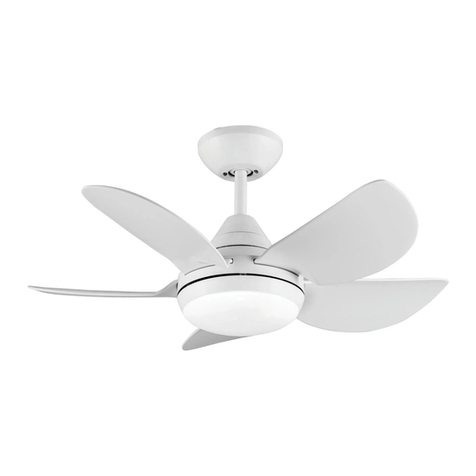
Sulion
Sulion RIAN manual
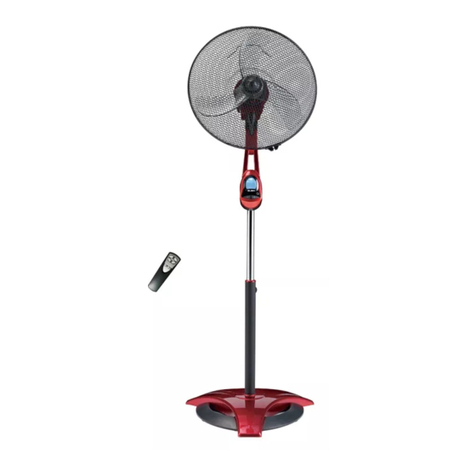
Elba
Elba ESF-A1631D(BL) owner's manual

Home Decorators Collection
Home Decorators Collection BERGEN Use and care guide
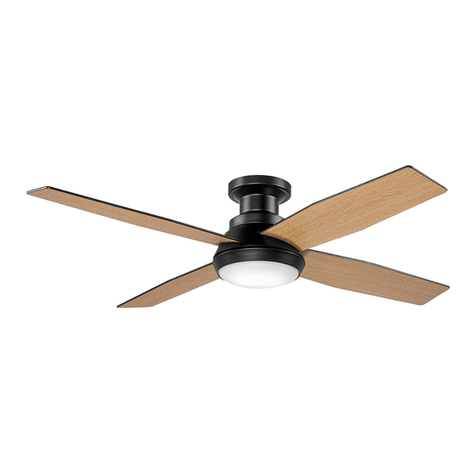
Swing
Swing BOULDER installation manual

cecotec
cecotec FORCESILENCE 9800 SKYLINE BLADELESS instruction manual
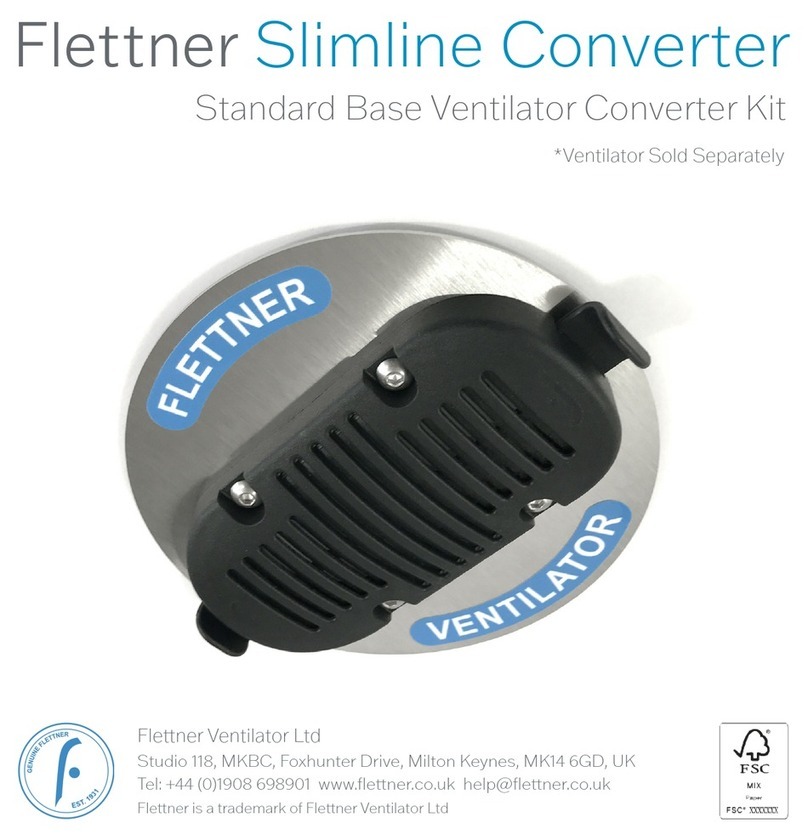
Flettner
Flettner Slimline Converter Fitting instructions


